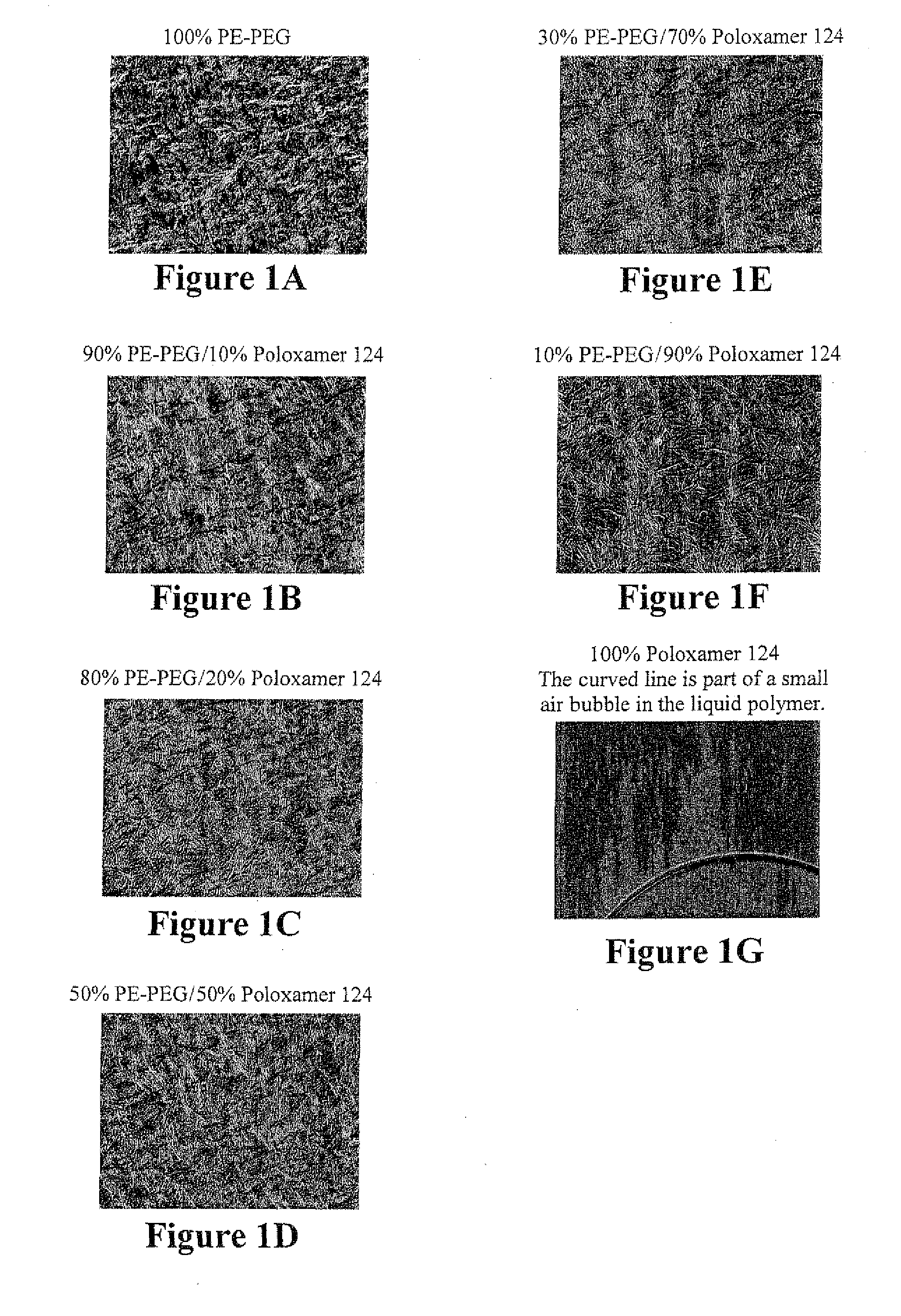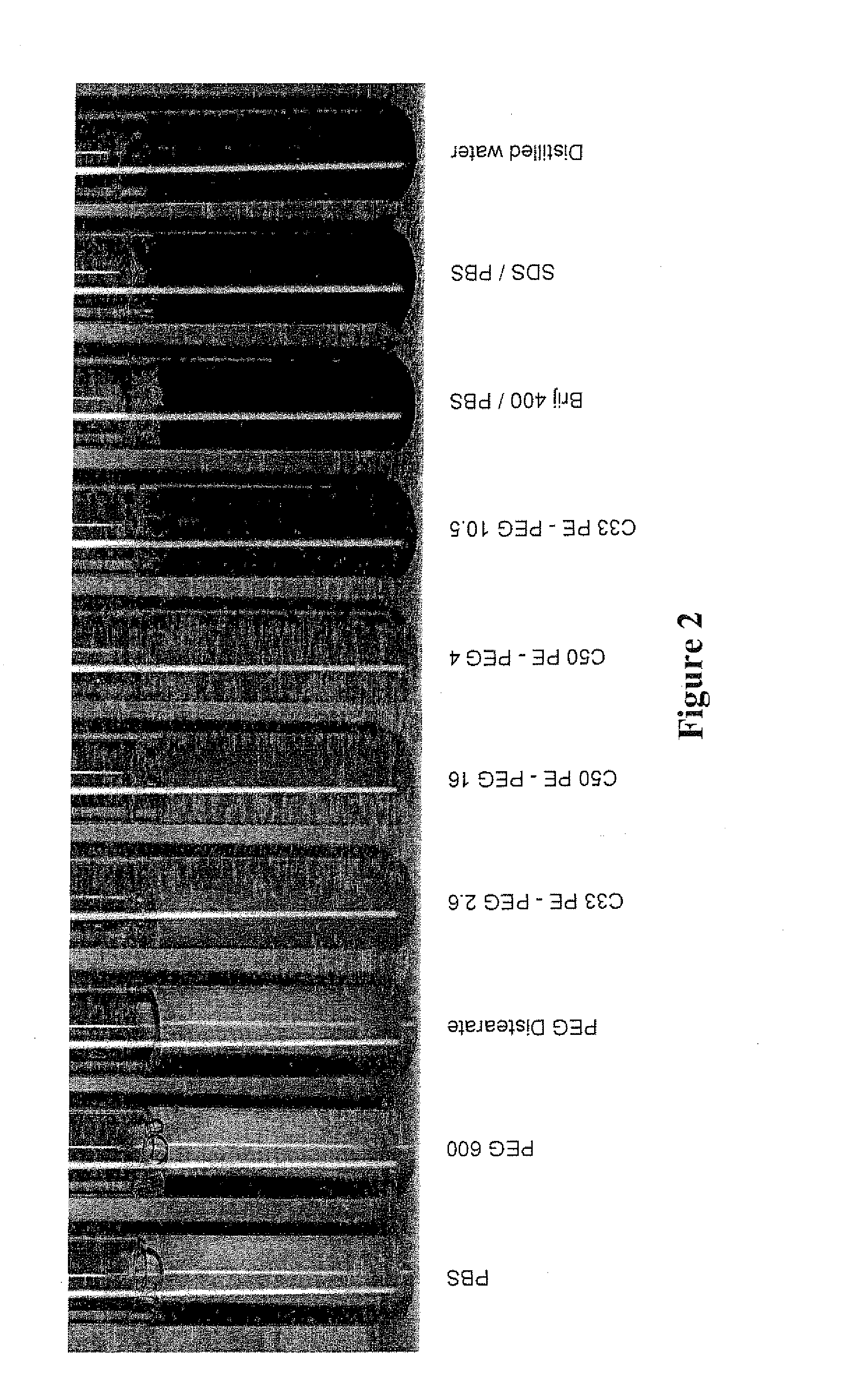Resorbable polymer compositions for use in medicine, dentistry, and surgery
- Summary
- Abstract
- Description
- Claims
- Application Information
AI Technical Summary
Benefits of technology
Problems solved by technology
Method used
Image
Examples
example 1
Macroscopic Characterization of PE-PEG Blends
[0057]Two different PE-PEGs, C50 PE-PEG 16, and C33 PE-PEG 2.6, were obtained from Sigma-Aldrich (St. Louis, Mo.). These were combined with several different polyalkylene glycol polymers and copolymers, and evaluated as follows
Method 1:
[0058]Appropriate amounts of PE-PEG and the second polymer were placed into a sealed borosilicate glass container, and incubated in a laboratory oven at 125° C. for 24 hours. The samples were then mixed thoroughly while hot, poured into prewarmed nonstick metal molds, and rapidly cooled by placing the mold onto a cold plate maintained at minus 10° C. When removed from the mold, the PE-PEG / polymer blend was in the form of solid bars of approximate dimensions 2″ by 0.6″ by 0.125″.
Method 2:
[0059]Borosilicate glass containers containing 10 g of PE-PEG and the second polymer in appropriate proportions heated in a laboratory microwave oven until as both components were observed to be fully melted (1 min to 2 min)...
example 2
Microscopic Evaluation of PE-PEG / Poloxamer Binary Blends
[0065]A poloxamer-PE-PEG combination that blended well and formed a smooth homogeneous single phase both in the molten and solid state was examined for evidence of any phase separation on the microscopic scale.
[0066]Method: C50 PE-PEG16 (Sigma-Aldrich) was blended with poloxamer 124 (P124) as described in Example 1 in proportions ranging from 10% P124 to 90% P124. While molten, approximately 20 microliters of each blend was placed onto a glass microscope slide preheated to approximately 150° C. and covered with a glass cover slide. The slide was then placed on a microscope equipped with Nomarski differential interference contrast optics, and observed at 400× magnification as the polymer blend cooled to room temperature.
[0067]Results: While liquid, blends of the two polymers were macroscopically water-clear with no turbidity, Schlieren effect, or other evidence of phase separation. Microscopically, it was apparent that the liqui...
example 3
Waxy PE-PEG Composition for Bone Hemostasis
[0071]A preferred waxy material with utility as a bone hemostasis agent may be produced in the following manner. Approximately 900 of C50 PE-PEG 16 and 100 g of poloxamer P124, preferably PLURONIC™ L44NF (BASF), are placed into a sealed PYREX® glass container and heated to a temperature of 110° C. in an oven. The flask is placed on a roller mixer until the contents are fully blended together to form a low-viscosity light yellow liquid, and then allowed to rest at 110° C. until all air bubbles have escaped from the liquid. The liquid is then dispensed directly into TEFLON® coated metal molds maintained at a temperature of 110° C. The molds are covered and allowed to cool to room temperature for up to 24 hours. The solid PE-PEG / polymer blend is removed and placed into individual foil packets lined with a polyethylene coating. These packets are then placed into pouches suitable for sterile implantable devices, and the hemostatic material is st...
PUM
| Property | Measurement | Unit |
|---|---|---|
| Temperature | aaaaa | aaaaa |
| Size | aaaaa | aaaaa |
| Size | aaaaa | aaaaa |
Abstract
Description
Claims
Application Information
 Login to View More
Login to View More - R&D
- Intellectual Property
- Life Sciences
- Materials
- Tech Scout
- Unparalleled Data Quality
- Higher Quality Content
- 60% Fewer Hallucinations
Browse by: Latest US Patents, China's latest patents, Technical Efficacy Thesaurus, Application Domain, Technology Topic, Popular Technical Reports.
© 2025 PatSnap. All rights reserved.Legal|Privacy policy|Modern Slavery Act Transparency Statement|Sitemap|About US| Contact US: help@patsnap.com


